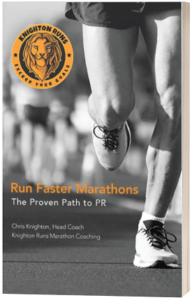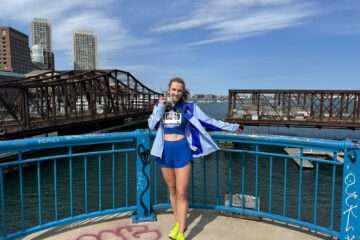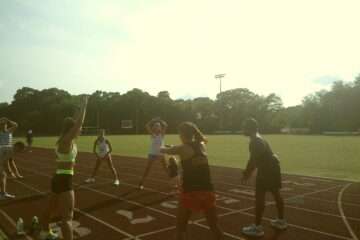How many running shoes should I own?

Written By: Coach Chris
I still have my feet on the ground, I just wear better shoes.
Oprah Winfrey
Overview
Every run has a purpose. Every shoe has a purpose. Match them together for the best training possible.
So how many pairs of running shoes should you own?
It is true that you can do all of your running in the same pair of shoes. For many beginner runners, this makes sense, as the outlay of cash for 5+ different styles of shoes can be prohibitive and unnecessary at first. But as you become more committed to the sport, you should strongly consider purchasing a different style of shoe halfway through the life of your current model until your running shoe quiver is full.
Performance-driven runners do not repeat the same type of run for multiple days on end in their training plans, and so too should their running shoe styles rotate throughout the week.
By never wearing the same pair of running shoes twice in a row, you distribute wear more evenly on your shoes. You also may help reduce your injury risk by mixing up the impact forces and movement patterns your body encounters throughout the week. Matching the right shoe to the purpose of the run will facilitate success in performing your run to plan.
The main types of shoes you should aim to have in your quiver are as follows:
- Easy Day Shoes
- Recovery Day Shoes
- Trail Running Shoes
- Long Run Shoes
- Workout and Race Shoes
In this article, I will explain the differences between shoe-types and share the model that has been my favorite lately. Note, I’m not saying these particular models will be the best for you, instead, they are what has worked for me. Try different brands and models until you find your favorites!
Easy Day Shoes
Think of your easy day shoe as your average, everyday shoe. It’s also got to be your best friend. You’ll wear these running shoes the most. If you are just starting out running, this is the pair you should buy first with. These everyday trainers are typically medium-weight, medium-cushion, and lower cost. While you can do workouts and races in these shoes, they are not built specifically for that job.
Easy day shoes are great for 30-90 minute runs at comfortable to moderate intensity levels and work equally well on roads or trails. If the weather is poor, these are probably the shoes you don’t care too much about getting messy. Having two models of easy day shoes in your quiver will ensure you always have a dry pair ready for the run ahead.
My favorite easy day running shoe is the Brooks Launch
I have been running in the Brooks Launch for 4+ years and have been through at least 10 pairs. I highly recommend the Brooks Launch because it is relatively low-weight, comfortable, inexpensive, and lasts me over 400 miles on average.


Recovery Day Shoes
Recovery Day shoes are a lot like easy day shoes, but with a couple of distinctive factors. Having extra cushion in your recovery day shoe will give a less jarring ride during your slow 30-60 minute recovery jogs. Having a shoe you are comfortable taking off-road is also helpful in a recovery day shoe since recovery days are best to run on soft surfaces.
In some cases, a recovery day shoe can double as a long run or even a highly cushioned workout shoe. The key is having an extremely comfortable shoe that you can rotate into throughout the week for slow, healing jogs. They should help you feel better after your run than before you started.
My favorite recovery day running shoe is the HOKA ONE ONE Rincon
I have been running in the HOKA ONE ONE Rincon for almost a year. I find it extremely comfortable for recovery runs, easy runs, long runs, and tempo workouts. It is very lightweight for the amount of cushion it provides. It may not be the most durable shoe in the world or have the best fitting upper on me, but the ride is to die for. This may just be my “jack-of-all-trades” shoe going forward.


Trail Running Shoes
Every runner who is serious about improving should own at least one pair of trail shoes. Running on soft surfaces should make up at least 50% of your mileage, and trail shoes are meant for this! While road running shoes work perfectly well in most unpaved conditions, having a dedicated trail shoe can be helpful in wet conditions as well as make you feel more confident running off-road.
Trail shoes run the gambit from light-weight racers to chunky trainers and everything in between. My general recommendation to start off would be to purchase a medium-to-high cushioned light-weight trail shoe. This shoe will serve you well both off roads and on them for easy and recovery days.
My favorite all-purpose trail shoe is the New Balance Fresh Foam Gobi Trail V3
I have been wearing the New Balance Fresh Foam Gobi Trail for several years and am on my third pair. This trail running shoe is extremely lightweight yet offers tremendous cushion. I’ve worn it on everything from short runs around my neighborhood on the pavement to 20+ mile adventure runs on and off-road. I love the low-cost and durability of this shoe and plan to keep buying them as long as they are made!


Workout and Race Shoes
These shoes are meant for going fast! To achieve your best performance on a workout or race day, you need a shoe that’s fit for the job. These shoes are typically very lightweight and have a low-cushion for a better ground-feel. These shoes are best if changed into after your warm-up, and taken off before your cool down.
I use three main types of workout or race shoes: racing flats, track spikes, and carbon-plated racing shoes.
Racing Flats
Racing flats are best for training at mile pace, 5K, 10K, and half marathon pace on the road or track. They could be worn for marathon-pace training but usually would not comfortable enough to wear for a full 26.2 miles. These lightweight, thin-soled shoes are great for feeling fast and nailing tough workouts. Historically these were also the fastest race shoes for distances 5K and up, but modern carbon-fiber shoe technologies seem to have one-upped them. That said, they still hold a place in every serious runner’s quiver for fast workouts, and the natural footstrike and stride they encourage.
My favorite racing flat running shoes are the ASICS Hyper Speed
I’ve had tremendous success in the 5K, 10K, and 1-mile in this shoe, setting personal bests along the way. They also are great for tempo runs. The durability of this should seems fantastic for both road racing and track.


Track Spikes
Track spikes are meant for training and racing on the track when raw speed is the ultimate concern. Cushion and upper frills are sacrificed for weight savings in these shoes, though modern ones can be surprisingly comfortable. There are special spikes for just about every event. If you don’t race 5K and under on the track, you probably will never need a pair. But, if you want to run your best in the mile to 5K, or just want to try something new and fun, a pair of spikes is an inexpensive investment.
My favorite track spikes are the Nike Zoom Victory 3. For Cross Country, I like the Nike Zoom Victory XC 5 Track Spike.
This is my first pair of racing spikes, but I love the shocking amount of comfort combined with the bare-foot feel these provide. As I work on improving my one mile to 5K time, I know these will be a great friend along the way. And they look fierce!


Carbon Fiber Plated Super Shoes
Nike made a huge splash with the introduction of the Nike 4% Marathon Running shoe and have since innovated further with the Next% Vaporfly and now Alphafly. These shoes undeniably now provide a significant advantage to the point of being unfair versus competitors who are not wearing them. Most shoe manufactures have comparable “super shoes” as of 2022. Adidas, Saucony and Puma all have good options.
The supreme cushioning of these shoes combined with lightweight and rigidity allows runners to race 5K-Marathon or perform workouts super-humanly fast with minimal fatigue.
My favorite carbon fiber super shoe is the Saucony Endorphin Pro 2

And for a non-carbon fiber racing shoe, check out the ASICS Hyper Speed which is even more affordable.





